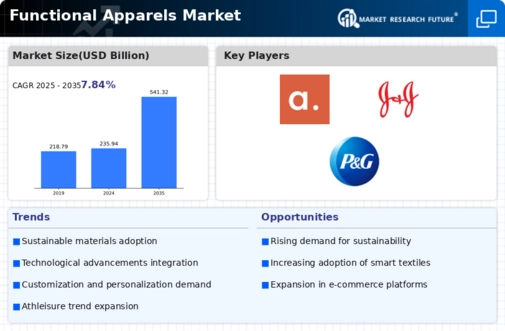Functional Apparels Size
Functional Apparels Market Growth Projections and Opportunities
Functional apparel, as a market, is a confluence of fashion, technology, and performance driven by various factors addressing consumers’ changing needs in search of clothes that go beyond beauty to useful functionalities. One key driver within this market is the growing emphasis on active and healthy lifestyles, which leads people to buy clothing that will support them in their activities and enhance their overall performance. Consumer preferences and demand for clothing with improved functionalities have a great impact on the Functional Apparel industry. Today's consumer seeks not only stylish clothes but also those that come with enhanced functionality such as moisture wicking, UV protection, and temperature regulation, among others. Economic factors significantly impact the Functional Apparel market whereby consumers are now willing to spend on high-quality Functional Apparel to support their activities. Technological advancements within textile and garment technology change from time to time because the industry continually evolves. Such innovations include moisture-wicking materials, anti-odor materials, smart textile fabric, and seamless construction, which improve functionality, convenience, and attractiveness of functional apparel at large. Cultural influences shape the Functional Apparel market alongside changing attitudes towards health and fitness. As perceptions about wellness change in society, brands may respond by adjusting their offerings of Functional Apparel products or marketing strategies they employ so as to conform to shifting consumer values. Demographic changes lead to shifts in patterns of consumption within the Functional apparel industry. Different age groups influence consumer choices through lifestyle options based on activities, hence prompting marketers to approach these issues differently through branded marketing strategies. Digitalization has become critical for advertising as well as accessibility into the market where it counts. The power of online platforms, e-commerce sites, a few examples being Facebook Market Place or even OLX Kenya, and social media when it comes to showcasing new designs while inspiring fitness or outdoor living as well direct communication channels between producers and considering buyers wanting the latest technologies associated with functional apparels. Consumer-to-consumer (C2C), Business-to-Consumer (B2C), and Business-to-Business (B2B) are some of the common types of e-commerce platforms. Meanwhile, the situation for other clothing segments is expected to worsen, with a USD 23.3 billion decline in sales projected for 2020, while utilitarian clothing is forecasted to be hit the hardest. Growing health and wellness trends will drive the post-COVID-19 recovery.







Leave a Comment